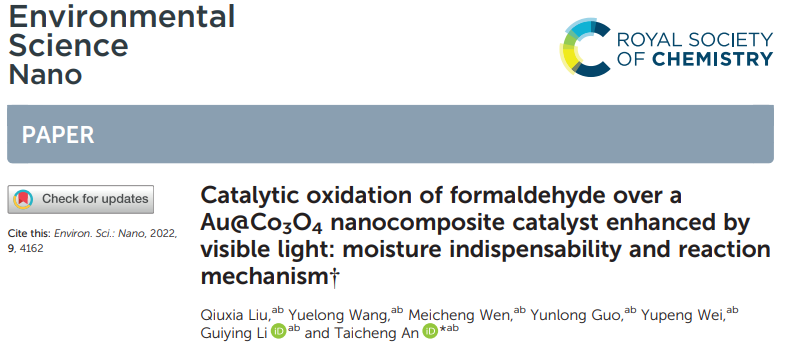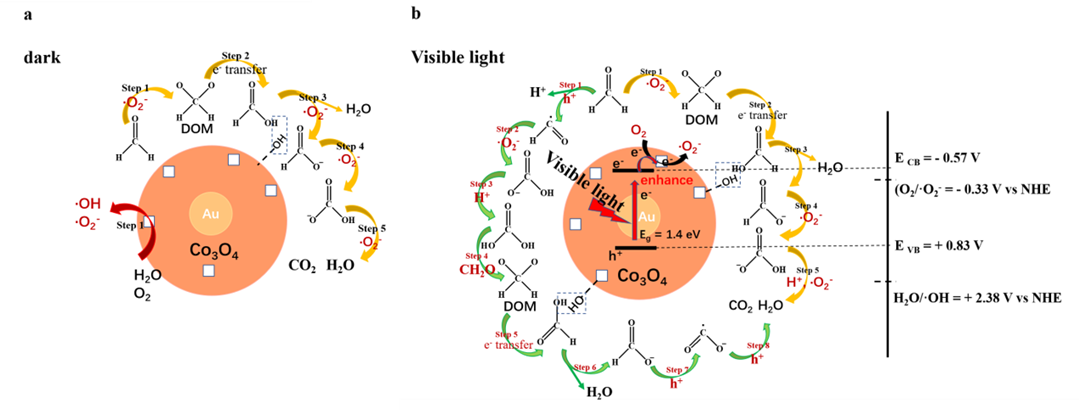近日,广东工业大学环境健康与污染控制研究院、环境科学与工程学院安太成教授团队在光催化降解甲醛方面取得最新研究进展,研究成果以《Catalytic oxidationof formaldehyde over a Au@Co3O4nanocomposite catalyst enhanced by visible light: Moisture indispensability and reaction mechanism》为题发表在Environmental Science: Nano(2022, 9, 4162-4176)期刊上。论文的第一作者为博士生刘秋霞,通讯作者为安太成教授。该工作采用了一种非常简单的合成方法来快速制备Au@Co3O4核-壳型纳米复合催化剂,并成功用于室温下消除甲醛。该文重点探讨了在Au@Co3O4催化剂上甲醛氧化的催化氧化和光催化增强的性能,再通过监测甲醛催化氧化和光催化增强氧化过程中的活性氧物种(ROSs)和中间副产物,研究了甲醛催化氧化的决速步和Au@Co3O4可见光增强甲醛氧化的催化反应机理,并推导了甲醛在无光催化氧化和可见光增强催化氧化下的降解途径。这项工作的发表有助于环境科学工作者在实践中合理设计可最大限度地利用可见光光谱的高效催化剂,且在实际应用中解决室内高浓度甲醛提供一种新的控制策略。

论文的网址:https://doi.org/10.1039/D2EN00679K
甲醛具有强烈的致癌和促癌作用,但是就目前而言,从室内空气中去除甲醛仍然具有挑战性。过渡金属氧化物如氧化钴(II,III)(Co3O4)是消除甲醛的潜在催化剂。然而Co3O4在室温下固有的低活性极大地限制了其用于室内空气净化。本研究中,我们设计了一种极其简单温和的方法来制备Au@Co3O4核-壳纳米复合催化剂,并探讨了Au@Co3O4在黑暗条件下和可见光照射下对甲醛催化氧化活性。实验结果发现这种材料不仅在无光条件下表现出较高的催化降解效率,而且在可见光照射下可以显著提高其光催化氧化甲醛的活性。应用电子顺磁共振和原位漫反射红外傅里叶变换光谱来鉴定了两个催化氧化反应过程中吸附在催化剂表面的活性氧物种和产生的降解中间体。实验发现Au@Co3O4可见光照射下高效光催化氧化甲醛主要归因于光生载流子促进了氧气和甲醛的活化,促进了二氧亚甲基中间体的形成,从而加速了甲酸和碳酸盐物种生成的关键步骤。该催化剂充分利用了可见光有效增强消除室内甲醛的基础研究,为光催化降解甲醛的机理提供了新的证据,也为合理设计环境净化的高效催化剂提供了理论基础。
图文摘要:

英文摘要:
Formaldehyde has strong carcinogenic and cancer-promoting effects, and its removal from indoor air is still challenging. Transition metal oxides such as cobalt(II,III) oxide (Co3O4) are potential catalysts to eliminate formaldehyde. However, the inherent low activity of Co3O4 at room temperature has greatly limited its utilization for indoor air purification. In this work, an extremely facile and mild method was designed to prepare a Au@Co3O4core-shell nanocomposite catalyst, and its catalytic and photocatalytic activity for formaldehyde oxidation were determined both under dark conditions and visible-light irradiation. This material exhibited not only high catalytic formaldehyde oxidation efficiency in the absence of light but also significantly promoted photocatalytic formaldehyde oxidation activity under visible-light irradiation. Electron paramagnetic resonance and in situ diffuse reflectance infrared Fourier transform spectroscopy were applied to identify the reactive oxygen species and the produced degradation intermediates which adsorbed onto the surface of the catalyst during the oxidation process. It was found that the enhanced catalytic activity of Au@Co3O4nanocomposite catalyst under visible-light irradiation was mainly attributed to the promotion of oxygen and formaldehyde activation by the photogenerated carriers, facilitating the formation of dioxymethylene and thereby accelerating the key step of the generation of formic acid and carbonate species. This fundamental study provides evidence for a catalytic mechanism of the photocatalytic degradation of formaldehyde and a basis for the rational design of catalysts that efficiently eliminate indoor formaldehyde through full use of visible light.
资助项目:本研究得到广东省重点领域研发计划项目(2019B110206002)、广东省创新科研团队(2017BT01Z032)和国家自然科学基金(42020104001,42007192和42077332)的支持。